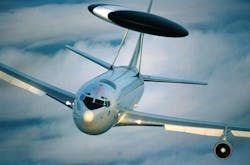Air Force considers major electronic upgrades to AWACS aircraft computers and sensors
Officials of the Air Force Life Cycle Management Center at Hanscom Air Force Base, Mass., have issued a request for information (BMC2-AMTI_RFI_20140402) for the Airborne BM/C2-AMTI Early Systems Engineering Effort, which involves avionics and electronics upgrades.
This initiative seeks to find enabling technologies in industry that would improve the AMTI and battle management/command and control capabilities of the AWACS aircraft -- a converted Boeing 707 jetliner that the Air Force uses for all-weather surveillance, command, control and communications, as well as for long-range airborne radar surveillance with its distinctive rotating radar dome above the fuselage.
Air Force officials are looking for technologies to help the AWACS perform AMTI and BM-C2 missions at lower cost, lower risk, and with improved capability, as well as to enable the AWACS to perform these missions amid enemy countermeasures like electronic jamming and fighter aircraft patrols.
Related: Avionics: ahead of the curve
The BM/C2-AMTI project seeks to upgrade AWACS onboard electronics with new subsystems or complete system replacements. Air Force experts particularly are interested in distributed and centralized assets; manned or unmanned vehicles; and one or more domains involving space, air, ground, and maritime.
Desired technologies should address survivability, sustainability, maintainability, and technical maturity beyond the year 2030. Concepts should address architecture information such as system-to-system interfaces and communications to include the primary types of information exchange.
For this project Air Force officials say "out-of-the-box" thinking is highly encouraged.
BM/C2 AMTI refers to exploiting near-real-time information, to manage airborne assets, and to conduct wide area surveillance. Functions include sensor management, data processing, information display, and secure encrypted communications that enable the AWACS aircraft to find, fix, track, target, engage, and assess (F2T2EA) air targets.
Related: ViaSat and Data Link Solutions get orders for MIDS-LVT situational-awareness data terminals
Technologies of interest include sensors, communication and network systems, computer, command and control visualizations, and man-machine interfaces. The capabilities need to support a future battlespace-awareness system that includes a common operational picture to allow battle managers to direct and cue assets such as surveillance and combat aircraft.
Air Force officials are looking for innovative BM/C2 AMTI concepts such as Defensive counter air (DCA);offensive counter air (OCA); strike missions; combat air patrols (CAP); OCA and DCA sweep; intercept; escort; suppression of enemy air defenses; active and passive electronic support missions (ESM); forward air control; close air support (CAS); reconnaissance and battle damage assessment; and anti-ship/maritime patrol missions.
The concepts should provide a means to accomplish these missions at lower cost, lower risk, and with improved capability to enable operations in an Anti-Access/Area Denial (A2/AD) environment. Those responding should address next-generation AMTI sensors able to perform advanced detection functions with improved size, weight, and power (SWaP), while taking advantage of new technologies.
Responders also should address detection of low observable targets; extended threat detection range and engage on remote; reduced time to close the kill chain loop from detection to engagement; combat identification (cooperative and non-cooperative) to support strategic and tactical decision superiority; and passive detection of surface emitters.
Related: Research initiatives pumping new life into phased-array radar
Key technical characteristics include monostatic, bistatic or multistatic concepts yielding agile, high sensitivity detection systems; advanced apertures with multibeam and multifrequency capabilities with software-defined frequency and phase scanning; advanced transmit and receive beam forming techniques; electronic protection against advanced electronic attack; and battle management.
Battle-management capabilities of interest include continuous air track surveillance, target and combat identification, battle damage assessment, and adaptive time critical targeting; blue force tracking and electronic identification; employment of weapons at optimal ranges, speeds, and altitudes; ability to identify, adapt to, and counter emerging threats; and open-architecture computers and software for collaborative databases within distributed, secure, encrypted, and anti-jam peer-to-peer networks.
Other battle-management capabilities should involve mission computing software support for information assurance, machine-to-machine interfaces for network-centric collaborative targeting; automated battle-management tools; filterable and configurable situational awareness; and improved information gathering.
Command-and-control systems may be centralized or distributed, and must be able to interoperate with the AF airborne network, the Army LandWarNet, the Navy FORCENet and with coalition partners.
Related: Relaxed AWACS temperature rules pave way for more COTS computers
Command and control should be able to access to a global net-centric environment with multi-level security; have beyond line of sight data solutions; offer voice and data communications; work together with advanced tactical data links; and have capability for rapid discovery/network joining, node authentication, and efficient network topology management.
Enabling technologies might include cognitive radio technologies that allow for dynamic spectrum access and can sense and learn the electro-magnetic environment to operate effectively and counter communication threats such as digital radio frequency memory (DRFM) jamming.
Email responses no later than 19 May 2014 to the Air Force's Bret Kreh at [email protected] and Harvey Tobin at [email protected]. Email Kreh or Tobin for questions or concerns.
More information is online at https://www.fbo.gov/spg/USAF/AFMC/ESC/BMC2-AMTI_RFI_20140402/listing.html.
